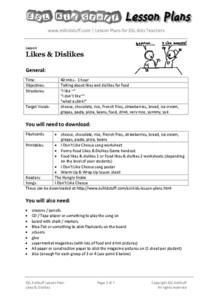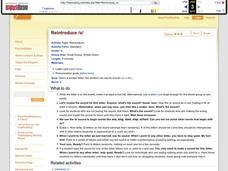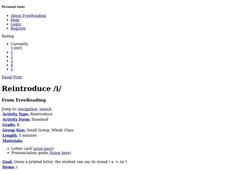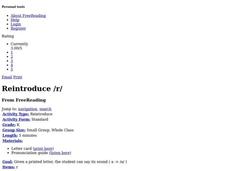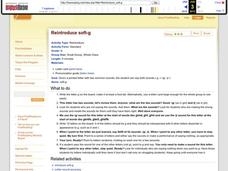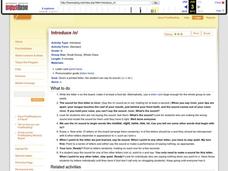ESL Kid Stuff
Christmas Lesson 1
Little ones sing Christmas carols, complete craft projects, and play word games while learning new vocabulary in part one of two-part ESL lesson series.
August House
The Ogre Bully
English language arts, math, science, dramatic arts, and cooking; this lesson plan has it all! In this multidisciplinary resource, your scholars will take part in a read aloud of The Ogre Bully by A.B. Hoffmire and have a grand...
Curated OER
Cross-Curricular Games
Students participate in exploring and examining several cross-curricular, hands-on games that encourage active learning and exercise at the same time. They assess games like Freeze Tag, Parts of Speech games and a healthy heart game, etc.
Curated OER
Five Quick Games Build Reading Skills
Build reading skills with these five quick games! Whether you're hoping to build grammar, syllabication, or word recognition skills, this resource has options for you. Kids will love taking a break from the mundane to play these...
Curated OER
Play Ball: A Major League Review Game
Apply the game of baseball to a fun review activity. Pupils earn a "base" for each subject question that they answer correctly. This activity can be modified and used for any subject area, including math, social studies, and language arts.
Curated OER
Hanukkah Fun: The Dreidel Game
Celebrate Hanukkah with an engaging lesson about the history of the dreidel! After reading or listening to a short description of the dreidel's place in the Hanukkah celebration, young learners work on their own dreidels from classroom...
ESL Kid Stuff
Christmas Lesson 2
Wrapping presents, singing Christmas carols, writing Christmas cards and learning holiday vocabulary are all wrapped into this one exciting ESL instructional activity.
ESL Kid Stuff
Toys
The world is a rainbow of colors in a set of lessons for English learners. Kids review colors with matching games and hide-and-seek, before singing songs about colors and reading a class story.
ESL Kid Stuff
Likes & Dislikes
Everyone has different preferences when it comes to food. Kids discuss the foods they like and dislike in a series of activities that include magazine cut-outs, singing a song about cheese, playing a group game, and reading a short story...
Curated OER
Introduce /o/
The best way to get your scholars familiar with the alphabet is to expose them to each letter in multiple contexts. This strategy incorporates letter recognition, sound, word examples, and pronunciation, and emerging readers will feel...
Curated OER
Reintroduce /s/
What letter is this? As you introduce pre-readers to letter sounds, keep them entertained with this fun game. Start by drawing the letter s on the board, large enough for all to see. Once you've demonstrated the sound it makes, use these...
Curated OER
Round-Robin Reading Quiz
Small groups of learners read text round-robin style, and then work individually to answer three questions based on the text. Next, they share their questions and responses and add ideas from the group. The reading strategies detailed...
Curated OER
Introduce /m/
Start by drawing a large letter m on the board for scholars to see. Do they know what letter this is? Once you've demonstrated the sound it makes, use these tips to help them make the same sound. There is even an audio pronunciation...
Curated OER
Introduce /f/
Hook your scholars by drawing a large f on the board; do they know what letter this is? Once you've demonstrated the sound it makes, use these tips to help them make the same sound. Although the audio function is neat, it may not be...
Curated OER
Introduce /d/
Give youngsters a better grasp of the letter d by combining letter sounds, pronunciation, recognition, and word examples. Scholars examine the letter shape then listen to you make the /d/ sound and try it on their own. Kids brainstorm...
Curated OER
Introduce /u/
As scholars are learning about letter sound correspondence use this activity to help them with the /u/ sound. Learners examine a large u on the board, identifying it if they can. They listen to you make its sound, explaining to them what...
Curated OER
Introduce /g/
As your emerging readers are learning the alphabet, set them up for success with strategies like these that incorporate multiple contexts and learning styles. Focusing on the letter g, write it clearly on the board. Model the /g/ sound,...
Curated OER
Reintroduce /t/
Use these strategies to connect letter pronunciation, sound, word examples, and recognition, focusing on the letter t. Emerging readers examine the letter and listen to you say the /t/ sound. As you explain how to do it, they try...
Curated OER
Reintroduce /i/
As your scholars begin learning letters of the alphabet, help them connect sound, pronunciation, word examples, and letter recognition using these strategies. Focusing on the letter i, begin by drawing it on the board. Can scholars...
Curated OER
Reintroduce /f/
Draw a large letter f on the board to begin this letter recognition and sounds activity, asking kids to identify it if they can. Demonstrate the /fff/ sound and explain how you are making it as learners try it out. What words can they...
Curated OER
Reintroduce /r/
The /r/ sound can be a difficult one, but scholars use some helpful tips to get it right. After examining the letter shape they listen to you pronounce this phoneme and describe what you are doing to create the sound. They try on their...
Curated OER
Reintroduce /o/
There are many words that begin with the /o/ sound; scholars study this letter in multiple contexts including intial phoneme examples, pronunciation, and letter recognition. Write the letter on the board to see if learners can identify...
Curated OER
Reintroduce Soft-g
Do your scholars know that the letter g sometimes steals the j phoneme? Explore the letter g using these strategies combining pronunciation, recognition, letter sound, and word examples. Scholars examine the letter shape and listen to...
Curated OER
Introduce /n/
What is this letter? Once your class is ready to explore the letter n, use these strategies to combine word examples, pronunciation, and letter recognition. First, can they identify the letter? Make the /n/ sound, explaining how you do...










